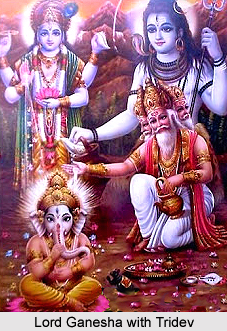 Lord Ganesha is worshipped and adored by the Tridev (Trimurti) or the Great Trinity of Lord Brahma, Lord Vishnu and Lord Shiva. Ganesha blessed them as the creator, preserver and destroyer of everything in the universe.
Lord Ganesha is worshipped and adored by the Tridev (Trimurti) or the Great Trinity of Lord Brahma, Lord Vishnu and Lord Shiva. Ganesha blessed them as the creator, preserver and destroyer of everything in the universe.
Legend of Worship of Lord Ganesha by Tridev
The Ganesha Purana cites that during the period of dissolution, the water and wind were demolished and the earth evaporated. Then Lord Brahma, Lord Vishnu and Lord Shiva began to consult and went to Naraka or netherworld to perform tapas; but it was unsuccessful.
The Tridev became exhausted and began to wander the earth which remained dark all over. The Gods spotted a lake in the darkness where an astonishing lustre appeared. They became fatigued and were unable to move. Then Brahma, Vishnu and Shiva stopped over at a particular location as they became extremely tired. There the Gods discovered huge lustre of light where Lord Ganesha was enshrined. The Tridev immediately bowed to the elephant headed Lord in reverence and began to worship and praise Him.
Ganesha became pleased by the prayers of the three Gods and told them to ask for a desirable boon. The Tridev said that they were unable to understand the reason for such occurrence. Hence, they requested Ganesha to bless them with the appropriate boon. The elephant Lord entrusted Lord Brahma, Lord Vishnu and Lord Shiva with three separate duties. Lord Brahma was instructed to engage in the task of the creation, Lord Vishnu was appointed as the preserver or maintainer of the people and Lord Shiva was assigned as the destroyer and transformer.
This article is a stub. You may enrich it by adding more information to it. You can send your write-up at content@indianetzone.com









